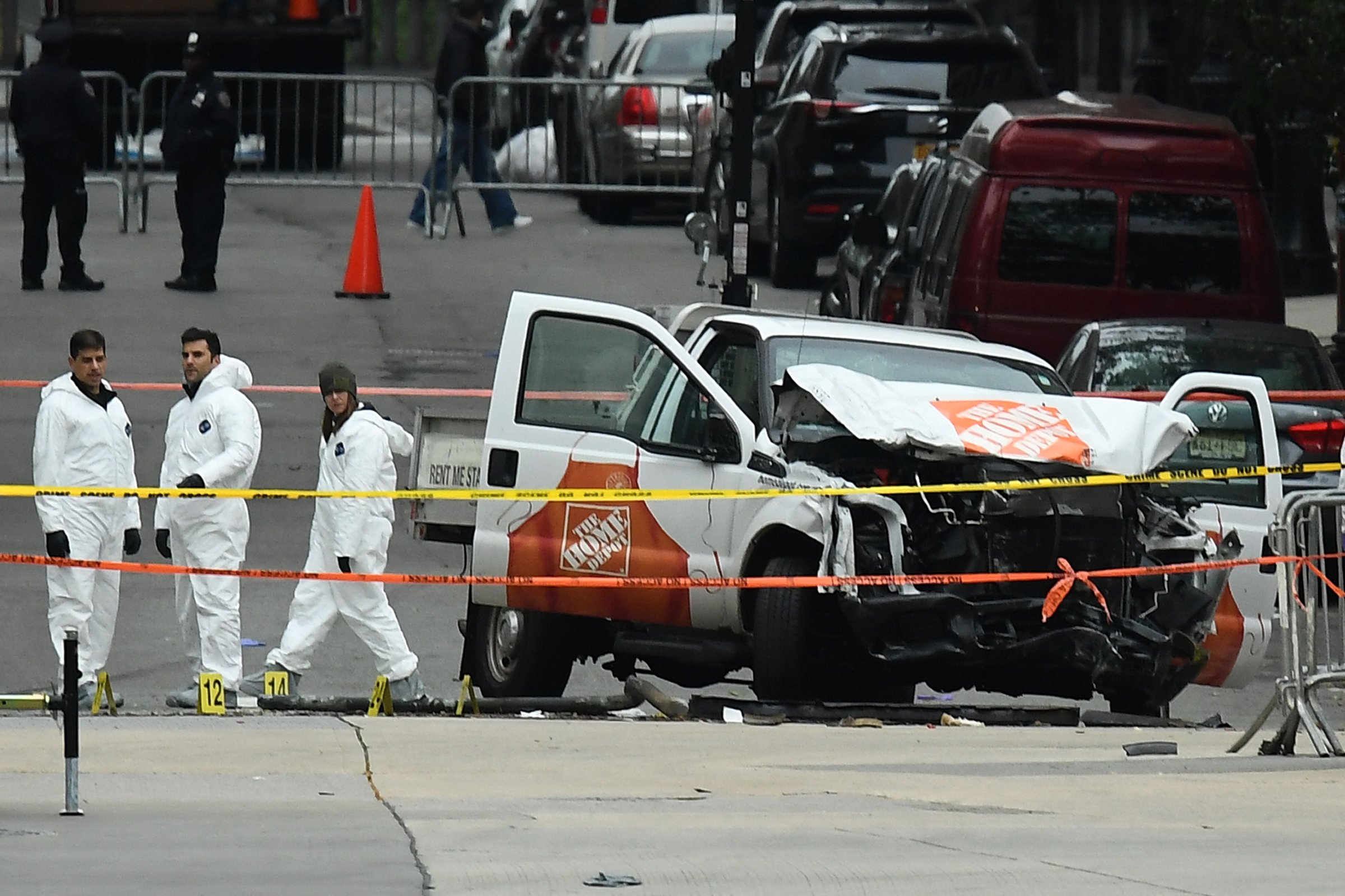
The pickup truck rampage that left at least eight people dead in lower Manhattan Tuesday was just the latest example of a grim trend in global militancy: The rising use of everyday vehicles to mow down pedestrians on busy city streets.
Prior to the New York attack, there were at least eight such assaults by armed groups and lone attackers since as recently as 2016, including attacks in France, the U.K., Spain and Germany.
Vehicular attacks have today become synonymous with ISIS, whose former chief strategist called for them in a 2014 address to the group’s followers. “Smash his head with a rock, or slaughter him with a knife, or run him over with your car, or throw him down from a high place, or choke him, or poison him,” said Abu Mohammad al-Adnani, calling for the murder of civilians in countries fighting ISIS. (Adnani was killed in a U.S. airstrike in Syria in 2016.)
ISIS has not yet formally claimed responsibility for Tuesday’s attack. But the suspect, Sayfullo Saipov, 29, acted “in the name of ISIS,” according to New York Police Department official John Miller, who spoke at a news conference on Wednesday. Miller added that Saipov appeared to have followed instructions released by ISIS, while handwritten notes found in Saipov’s vehicle reportedly linked him to the group.
Car attacks have become a key tactic in ISIS’ worldwide killing campaign because they require few resources, almost no training, and minimal planning. They also weaponize everyday vehicles and turn public spaces into killing zones. As a result, they are nearly impossible to defend against. “The insight is anyone can pull this off, even when there are defensive countermeasures put in place,” said Clint Watts, a former FBI counterterrorism special agent and U.S. Army officer, in a phone interview. Vehicular terrorism also dovetails with ISIS’ recent strategy of inspiring lone assailants rather than orchestrating grandiose attacks from afar. Such attacks are expected to continue as ISIS loses ground in Iraq and Syria, where it’s based.
Even still, the weaponization of cars and trucks long predates ISIS, with instances of such attacks in countries from Canada to China. In 2001, a man from Gaza drove a bus into a group of Israeli soldiers, killing eight. Also in 2001, a big rig truck burst into blames after a man drove it into California’s capitol building, drawing comparisons to a suicide bombing. In 2006, Mohammed Reza Taheri-azar drove a sport utility vehicle through the campus of UNC Chapel Hill; he later said he intended to “avenge the death of Muslims worldwide.”
Even in the worldwide jihadist movement, the idea of motor vehicle killings circulated long before ISIS erected its empire. In 2010, Al-Qaeda in the Arabian Peninsula published an article in its propaganda magazine, Inspire, that called for the use of pickup trucks as a “mowing machine, not to mow grass but mow down the enemies of Allah.”
Then came Nice. On July 14, 2016, a man drove a cargo truck through crowds celebrating Bastille Day in the seaside French town, killing 87 people including the driver. The rampage was one of ISIS’ deadliest attacks in Europe, and it stamped vehicular attacks as one of the group’s signature tactics. ISIS began spotlighting the strategy in its propaganda, publishing videos and instructions on how to kill people with trucks. “They very systematically went about positioning vehicle attacks as an [ISIS] hallmark,” says Charlie Winter, a terrorism researcher with the International Centre for the Study of Radicalisation and Political Violence in London.
Car and truck killings surged in the year following the Nice attack. In December 2016, a driver steered a truck into Berlin’s famed Christmas market, killing 12 people. In March 2017, an attacker smashed into pedestrians on London’s Westminster Bridge before stabbing a police officer. In April, a man rammed a stolen truck into a crowd in Stockholm, killing four people. In June, three people driving a van ran down pedestrians on London Bridge. In August, yet another attacker ran down people on an iconic boulevard in Barcelona, killing 13.
Winter, the terrorism analyst, said such attacks were the result of improvisation rather than a grand strategy. “People are essentially copying what works. It’s very clearly something that doesn’t take much planning and can have a high impact. I think it’s that rather than some kind of organizational ingenuity on [ISIS’] part,” he said in a phone interview.
Cities around the world are bolstering their defenses against car attacks. Many are installing “bollards,” short yet sturdy posts that can stop a vehicle’s forward movement. Urban designers, meanwhile, are increasingly thinking about other ways to keep public spaces safe.
Such moves are becoming increasingly urgent as extremist groups across the political spectrum appear to be adopting car attacks as a murder tactic. In June, a British man plowed a van into pedestrians near London’s Finsbury Park Mosque, wounding eight people. Witnesses reportedly heard the driver shouting, “I want to kill Muslims.” In August, a man drove a car into a crowd of demonstrators in Charlottesville, Virginia who had gathered to denounce a white supremacist rally; one woman was killed. “This has seemingly become the new modus operandi of all violent groups, and I’m sure it will continue moving forward,” said Watts.
More Must-Reads from TIME
- Why Trump’s Message Worked on Latino Men
- What Trump’s Win Could Mean for Housing
- The 100 Must-Read Books of 2024
- Sleep Doctors Share the 1 Tip That’s Changed Their Lives
- Column: Let’s Bring Back Romance
- What It’s Like to Have Long COVID As a Kid
- FX’s Say Nothing Is the Must-Watch Political Thriller of 2024
- Merle Bombardieri Is Helping People Make the Baby Decision
Contact us at letters@time.com